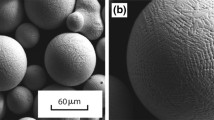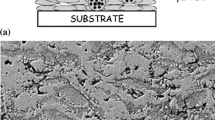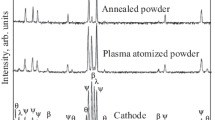Conclusions
In the manufacture of a Eu2O3 powder for plasma-spraying, preparatory treatments such as sintering and plasma spheroidization have no effect on the chemical composition of the starting product. Plasma spheroidization of a Eu2O3 powder increases the amount of the high-temperature phase by 20% compared with sintering, but a spheroidized powder is more suitable for plasma-spraying. At specific plasma jet enthalpies in the range from 12 to 20 kW·sec/g no thermal dissociation of europium oxide or reaction between the compound and the plasma jet takes place. Plasma-deposited layers applied at specific enthalpies ranging from 12 to 15.2 kW·sec/g contain only the monoclinic high-temperature phase of europium oxide. Increasing the specific plasma jet enthalpy in deposition to above 15.2 kW·sec/g leads to the appearance of the cubic europium oxide phase in the coating. The grain size of plasma-deposited Eu2O3 coatings decreases with increasing specific enthalpy of the plasma jet. Increasing the specific enthalpy of the plasma jet from 12 to 15.2 kW·sec/g reduces the crystal lattice parameter c of europium oxide, but further increase in specific enthalpy produces no further change in this parameter. With increasing specific enthalpy of the jet, the crystal lattice parametera of Eu2O3 at first, between 12 and 16.2 kW·sec/g, decreases and then, between 16.2 and 20 kW·sec/g, steadily grows. No chemical reaction takes place between a europium oxide coating and a D16 aluminum alloy substrate.
Similar content being viewed by others
Literature cited
V. S. Loskutov, B. G. Arabei, B. N. Gorshkov, and Yu. V. Smirnov, “Plasma-spraying of rare-earth oxides and hexaborides,” in: New Methods of Application of Spray-Deposited Coatings, Abstracts of Papers and Communications to an All-Union Scientific-Technical Conference [in Russian], Voroshilovgrad (1976), pp. 128–129.
L. I. Dekhtyar' et al., “Determination of the elasticity characteristics of and residual stresses in plasma-deposited coatings,” in: Theory and Practice of Plasma-Spraying [in Russian], Moscow (1977), pp. 104–111. (Tr. Mosk. Vyssh. Tekh. Uchil., No. 237, Pt. 1.)
A. Khasui, Spray-Deposition Technology [in Russian], Mashinostroenie, Moscow (1975).
V. A. Vishnevskaya, Z. A. Konstant, et al., “Reactions of magnesia and alumina in a high-temperature gas stream,” Izv. Akad. Nauk Latv. SSR, Ser. Khim., No. 1, 14–18 (1969).
Author information
Authors and Affiliations
Additional information
Translated from Poroshkovaya Metallurgiya, No. 12(228), pp. 87–91, December, 1981.
Rights and permissions
About this article
Cite this article
Gorshkov, B.N., Loskutov, V.S., Gavrish, A.A. et al. X-ray structural investigations of plasma-sprayed europium oxide. Powder Metall Met Ceram 20, 899–902 (1981). https://doi.org/10.1007/BF00789208
Received:
Issue Date:
DOI: https://doi.org/10.1007/BF00789208




